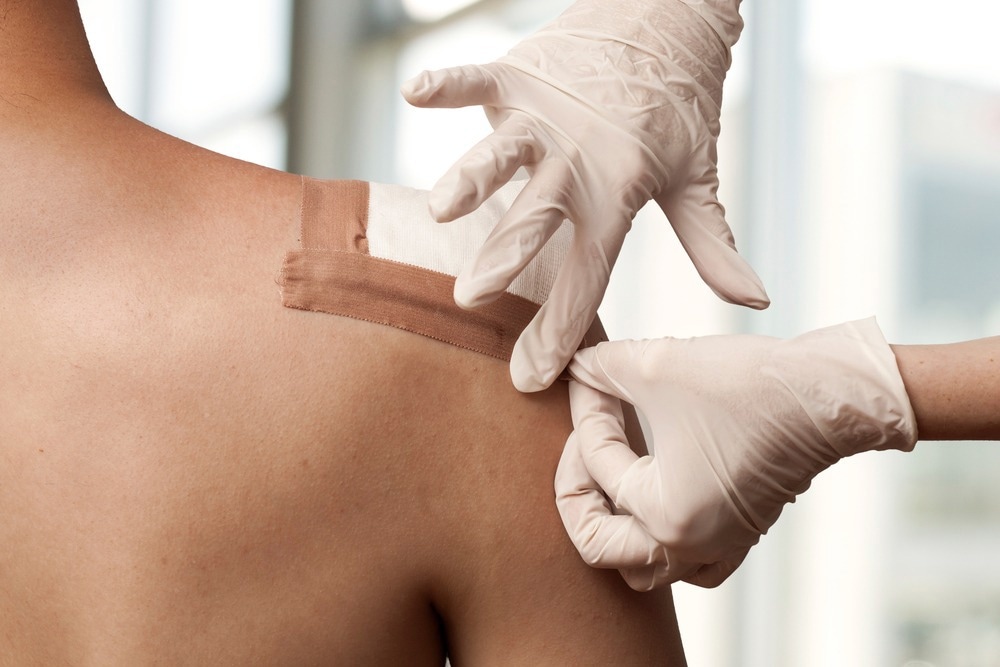Hydrogels are promising candidates that mimic the native skin microenvironment due to their porous and hydrated molecular structure.

Study: Wet Electrospun Nanofibers-Fortified Gelatin/Alginate-Based Nanocomposite as a Single-Dose Biomimicking Skin Substitute. Image Credit: Impact Photography/Shutterstock.com
In an article recently published in the journal ACS Applied Bio Materials, nanofiber (NF)-reinforced hydrogel (HG) nanocomposites were fabricated for wound healing. The NF-fortified HG mimicked the extracellular matrix (ECM) and served as a skin substitute for wound healing.
The NF-reinforced HG matrix was composed of sodium alginate (SA) and gelatin (GE), antimicrobial Punica granatum extract (PE) along with hyaluronic acid (HA). Furthermore, the HG nanocomposites crosslinked with N-(3-(dimethylamino)propyl)-N′-ethyl carbodiimide hydrochloride (EDC) were reinforced with fragmented trans-ferulic acid (FA)-loaded cellulose acetate/polycaprolactone (PCL/CA) NFs.
The nanofibers used to fortify HG nanocomposites were prepared by wet electrospinning the coagulating solution of poly (vinyl alcohol) (PVA), to mimic the porous ECM fibers. The designed reinforced skin substitute for wound healing application offered the tunability of mechanical and physical properties, along with their intrinsic porous microstructure.
The designed HG nanocomposites for wound healing were characterized using differential scanning calorimetry (DSC), Fourier transform infrared (FTIR) spectroscopy, and electron microscopy. Moreover, the HG nanocomposites were studied for their biocompatibility, biodegradability, bioactivity, and in vitro drug release kinetics to confirm their practical applicability in wound healing.
Nanocomposites in Wound Healing Process
Wound healing is a complex skin repairing process that begins immediately after an injury to the epidermal layer and might take days to years. This dynamic wound healing process includes highly organized cellular, humoral, and molecular mechanisms. Wound healing has three overlapping phases: inflammation, proliferation, and remodeling. Any disruption to these phases could lead to abnormal wound healing.
A nanocomposite is a combination of two or more materials, of which nanomaterial is at least one of the components, with unique physicochemical properties. Nanocomposite materials are fabricated to exhibit properties that exceed the capabilities of the sum of their constituents. The materials embedded into nanocomposites are called the reinforcing materials embedded in another material called the matrix.
The existing trend of regenerative medicine encourages the replacement of damaged natural tissue with three-dimensional (3D) skin substitutes, representing the natural ECM. Consequently, the skin substitute enhances the interactions of the cell materials and promotes tissue regeneration. To this end, hydrogels serve as 3D water-rich scaffolds, exhibiting elastic properties like natural soft tissue.
Although the porosity of hydrogels enables the absorption of exudates and maintains the moisture balance, they lack mechanical properties and are highly susceptible to degradation. However, the insertion of nanofibers into the hydrogel crosslinked matrix results in hybrid fortified nanocomposites, which exhibit optimal pore structure that maintains the water balance and prevents cell migration in 3D hydrogels.
NFs-Fortified Gelatin/Alginate-Based Nanocomposites for Wound Healing
In the present work, an HG-based skin substitute was developed from ECM mimicking NFs-reinforced HG nanocomposites and was evaluated for its wound healing capacity. The HG matrix that served as a skin substitute was composed of SA, GE, PE antimicrobial agent, and HA vital components, like in natural ECM.
The crosslinking of HG with EDC cross-linker and reinforcement with fragmented FA-loaded PCL/CA NFs resulted in highly competent nanocomposites, wherein the nanofibers were fabricated by wet electrospinning into a coagulating solution of PVA, resembling ECM fibers. Moreover, this 3D hybrid matrix was hypothesized to facilitate the cells to identify both the NFs structure and the water-rich environment, mimicking the ECM.
Additionally, the designed skin substitute endowed tunable mechanical properties, excellent physical properties, and a highly porous microstructure. The characterization results revealed that the plain and FA-loaded NFs had average diameters of 210 ± 12 and 452 ± 25 nanometers, respectively.
Furthermore, an excisional full-thickness defect model was considered to conduct in vivo studies to assess the wound healing and skin regeneration properties of designed HG nanocomposites. The results showed that the constructed HG nanocomposites demonstrated good antimicrobial properties, cytocompatibility, free-radical scavenging activity, water absorption capability, porosity, and good bioavailability.
Moreover, the ECM-mimicking HG nanocomposites showed outstanding wound-healing activity with their single-dose treatment ability against wounds of 0.95-millimeter diameter after 15 days. Additionally, with the help of histological investigation of the wound area, it was observed that the HG nanocomposites that served as skin substitutes could enhance the process of wound healing and improve skin regeneration.
Conclusion
To summarize, a skin substitute mimicking the natural ECM was fabricated by reinforcing the HG matrix with NFs. The developed HG nanocomposites were incorporated with key components of native ECM. Consequently, the skin substitute was composed of GE/SA HG fortified with fragmented PCL/CA NFs.
The fabrication method was facile without the need for complicated, difficult techniques. The prepared HG nanocomposites showed tunable mechanical characteristics, excellent physical properties, and a highly porous microstructure. Moreover, the HG nanocomposite has the advantage of being a single-dose skin substitute for efficient wound healing and skin regeneration.
Reference
Aboomeirah, AA., Sarhan, WA., Khalil, EA., Abdellatif, A., Dena, ASA., El-Sherbiny, IM. (2022) Wet Electrospun Nanofibers-Fortified Gelatin/Alginate-Based Nanocomposite as a Single-Dose Biomimicking Skin Substitute. ACS Applied Bio Materials.https://pubs.acs.org/doi/10.1021/acsabm.2c00147
Disclaimer: The views expressed here are those of the author expressed in their private capacity and do not necessarily represent the views of AZoM.com Limited T/A AZoNetwork the owner and operator of this website. This disclaimer forms part of the Terms and conditions of use of this website.